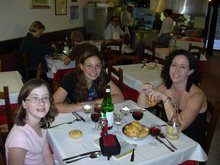
BIBLIOGRAPHY
Kearney, Meg. 2005. THE SECRET OF ME. Persea Books: New York.
Semi-autobiographical, Meg Kearney's book in verse chronicles the teenage angst and happenings of Lizzie and her two siblings. Lizzie, age fourteen, is adopted, as are her older brother and sister, Kate and Bob. While Kate and Bob are fairly comfortable with the fact they are adopted, Lizzie cannot stop thinking about her birthmother and wondering about her. In Lizzie's home, the children know they are adopted, but it is a taboo subject to discuss, and only close friends and relatives know of their adoptions.
Over the span of a year, Lizzie tells her story in verse. Some of her poems tell of everyday teenage happenings, such as her crush on a boy, Peter, and everyday occurrences such as school and basketball. Lizzie also talks of her close friends, all of whom are also adopted; they don't understand Lizzie's wish to know something about her birthmother. The "secret" in the McLane household is the fact the children are adopted, and Lizzie worries her mom will be hurt if she knows of Lizzie's desires. Some of the poems are called "What I remember", and for each season, Lizzie tells of the memories her family are making, such as sitting on Santa's lap in Macys, and having hot pretzels with salt at Christmas. Other poems are called "Broken Place"; these poems are Lizzie's dark thoughts when she is feeling down and depressed. As the year progresses, Lizzie agonizes about telling Peter that she is adopted, and talking to her parents about her adoption. Through personal growth, Lizzie is able to do both of these things and have positive outcomes with both Peter and her dad.
The book has a table of contents listing each poem by title. Kearney includes a lengthy afterw0rd, in which she talks openly about her adoption experience and those of her brother and sister. She compares her life to that of Lizzie's, telling of the similarities and differences in their lives. Following the afterword is a fascinating section called "Guide to This Book's Poetics". The poems in this book are a combination of free verse, and other verse forms including sonnets, sestinas, and villanelles. Each poem type is described and poems that follow each style are highlighted. This section is particularly helpful for teacher of poetry and for students wishing to expand their poetic repertoire. There is also a section devoted to the poems that Lizzie mentions in her poems; having these poems helps to further the flow of the poems and the story. By using different forms of verse, Lizzie's story and voice is fully developed as different types of poems are used for different purposes. Lizzie uses list poems to list "Things I Love So Much I Could Give Them Away"; the list is blank. and "When I Was Little", in which Lizzie worries about her birthmother coming back to get her if she misbehaves or gets bad grades. Free verse poems are used when the reader needs to follow the flow of the poetry, such as "The Wave". This is a poem in which Lizzie talks about when her dad has a heart attack and her worries about him.
This book should have wide appeal for all teenagers, whether adopted or not. Adopted teenagers in particular should relate to Lizzie's feelings, thoughts, and experiences. The book effectively molds Lizzie as a likeable and believable character, and as you read, you feel as if you are experiencing Lizzie's worries and trepidations.


